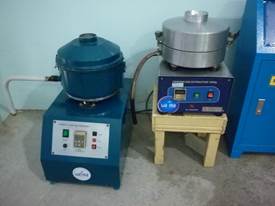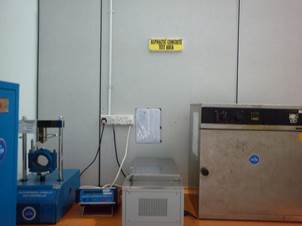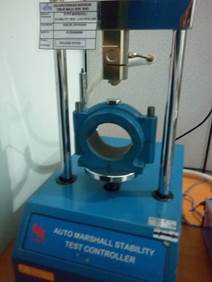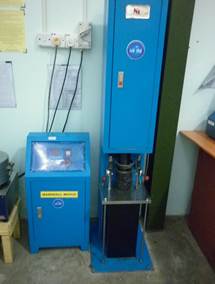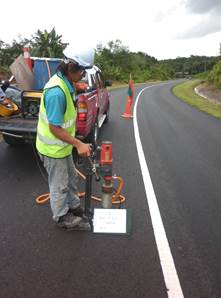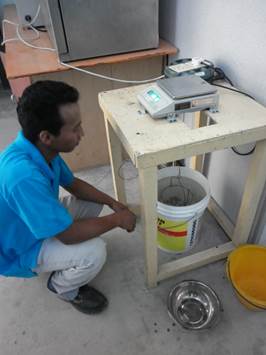Soil, Foundation, Geotechnical and Geological Specialist.......
|
|
|
|
Bituminous / Asphalt Premix
a) Bitumen Content/Extraction Test (ASTM D 2172 – 92)
b) Determination of Marshall Stability and Flow Test (ASTM D 1559 – 89) c) Automatic Marshall Compactor Test (ASTM D 1559 - 89) d) Asphalt Mix Design Analysis e) Asphaltic Concrete Core Test f) Asphaltic Concrete Core Density Test
(a) BITUMEN CONTENT/EXTRACTION TEST (ASTM D 2172 – 92)
The suitable bitumen content for a bituminous paving mixture was determined through laboratory Marshall Design method. The optimum bitumen content obtained from this method will be used as a guide to produce hot mix asphalt at a premix plant. To ensure the bitumen content used in the paving mixture is as designed, extraction of bitumen form bituminous paving mixture has to be conducted. This is carried out for the purpose of specification acceptance, quality control and assessment, and research.
This test is done to determine the bitumen content as per ASTM 2172. The apparatus needed to determine bitumen content are:- i) Centrifuge extractor ii) Miscellaneous – bowl, filter paper, balance and Methyaline Chloride
(b) Determination of Marshall Stability and Flow of Bituminous Mixture (ASTM D 1559 – 89)
The Marshall Stability and Flow test is done to determine the Marshall stability and
Flow of bituminous mixture as per ASTM D 1559. The principle of this test is that
Marshall Stability is the resistance to plastic flow of cylindrical specimens of a
bituminous mixture loaded on the lateral surface. It is the load carrying capacity
of the mix at 60°C and is measured in kg. The apparatus needed to determine Marshall Stability of bituminous mixture is
(c) AUTOMATIC MARSHALL COMPACTION TEST (ASTM D 1559 – 89)
The Marshall Test is used to measure physical properties of asphalt specimens that relate to plastic deformation properties
of asphalt mixes. The test is carrying out using automatic Marshall Compactor. It automatically compact the specimen and
stops off the motor after the preset number of strokes has been completed on the automatic digital display counter. The trip
mechanism is structured so that the hammer falls at the same height at every stroke. The drive mechanism lifts the 4.53 kg
compaction hammer plated against corrosion, to the height of 457+3mm and allows free fall at 75 blows each side.
At least 3 parallel test specimens should be prepared. Each specimen requires approximately 1200g of bituminous material
and heats the individual 1200g samples in a 140°C (285°F) oven. The mass required should be adjusted so that ach test
specimen has a height of 63.5 ± 1.3 mm after compaction. Immediately after compaction, remove the compacted specimen from
the mold and allow it to cool to room temperature.
(d) ASPHALT MIX DESIGN ANALYSIS
The design of hot mix asphalt mixes involves determining an economical blend of aggregates that provides a combined
gradation within the limits of the specifications and a determination of the percent of asphalt binder to mix with the
aggregate blend, which provides a mix, which meets volumetric specifications. Trial mixes prepared with different binder
contents are tested for mix properties (approximately 15 samples are required to be prepared) and the results are
analyzed to select the optimum binder content (OBC) that is judged to be most satisfactory for the intended use of the mix.
(e) ASPHALTIC CONCRETE CORE TEST
Asphaltic Concrete coring of the existing pavement surface takes all the guesswork out of the equation and provides the proper method for any construction or maintenance that may be required. Asphaltic Concrete coring test is an extremely precise tool used during new construction to verify quality, as well as a tool to evaluate existing asphalt pavements for potential problem with asphalt and base material. Core testing provide the most accurate in-place information. Soil classification and thickness of pavements are important variable to understand when planning a paving project.
The core testing can provide information to determine pavement thickness, bond between pavement layers and soil type under pavement.
(f) Asphaltic Concrete Core Density Test
Samples of asphalt concrete collected using the coring method may be used to evaluate various characteristics of an asphalt concrete pavement for construction quality control testing, quality assurance testing and product acceptance testing. Core samples may also be used for research testing purposes.
Cores are extracted from a pavement after the pavement is laid, thus making it a destructive process. Bulk specific gravity measurements are then made on the cores in a laboratory. The methods of measuring bulk specific gravity of cores include: a) saturated surface-dry method |

